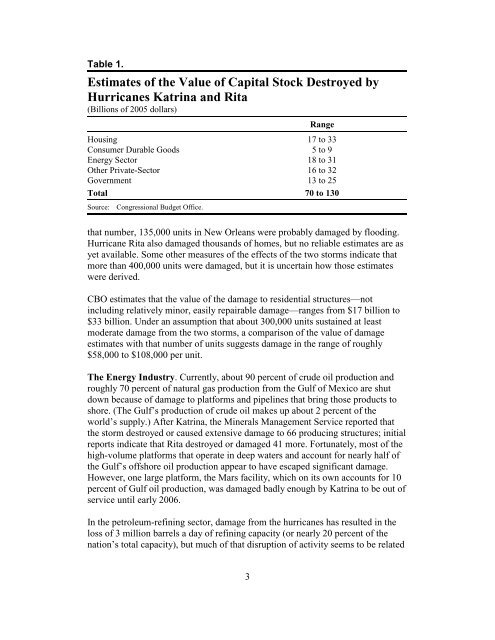Macroeconomic and Budgetary Effects of Hurricanes Katrina and Rita
Macroeconomic and Budgetary Effects of Hurricanes Katrina and Rita
Macroeconomic and Budgetary Effects of Hurricanes Katrina and Rita
Create successful ePaper yourself
Turn your PDF publications into a flip-book with our unique Google optimized e-Paper software.
Table 1.<br />
Estimates <strong>of</strong> the Value <strong>of</strong> Capital Stock Destroyed by<br />
<strong>Hurricanes</strong> <strong>Katrina</strong> <strong>and</strong> <strong>Rita</strong><br />
(Billions <strong>of</strong> 2005 dollars)<br />
Range<br />
Housing 17 to 33<br />
Consumer Durable Goods 5 to 9<br />
Energy Sector 18 to 31<br />
Other Private-Sector 16 to 32<br />
Government 13 to 25<br />
Total 70to130<br />
Source: Congressional Budget Office.<br />
that number, 135,000 units in New Orleans were probably damaged by flooding.<br />
Hurricane <strong>Rita</strong> also damaged thous<strong>and</strong>s <strong>of</strong> homes, but no reliable estimates are as<br />
yet available. Some other measures <strong>of</strong> the effects <strong>of</strong> the two storms indicate that<br />
more than 400,000 units were damaged, but it is uncertain how those estimates<br />
were derived.<br />
CBO estimates that the value <strong>of</strong> the damage to residential structures—not<br />
including relatively minor, easily repairable damage—ranges from $17 billion to<br />
$33 billion. Under an assumption that about 300,000 units sustained at least<br />
moderate damage from the two storms, a comparison <strong>of</strong> the value <strong>of</strong> damage<br />
estimates with that number <strong>of</strong> units suggests damage in the range <strong>of</strong> roughly<br />
$58,000 to $108,000 per unit.<br />
The Energy Industry. Currently, about 90 percent <strong>of</strong> crude oil production <strong>and</strong><br />
roughly 70 percent <strong>of</strong> natural gas production from the Gulf <strong>of</strong> Mexico are shut<br />
down because <strong>of</strong> damage to platforms <strong>and</strong> pipelines that bring those products to<br />
shore. (The Gulf’s production <strong>of</strong> crude oil makes up about 2 percent <strong>of</strong> the<br />
world’s supply.) After <strong>Katrina</strong>, the Minerals Management Service reported that<br />
the storm destroyed or caused extensive damage to 66 producing structures; initial<br />
reports indicate that <strong>Rita</strong> destroyed or damaged 41 more. Fortunately, most <strong>of</strong> the<br />
high-volume platforms that operate in deep waters <strong>and</strong> account for nearly half <strong>of</strong><br />
the Gulf’s <strong>of</strong>fshore oil production appear to have escaped significant damage.<br />
However, one large platform, the Mars facility, which on its own accounts for 10<br />
percent <strong>of</strong> Gulf oil production, was damaged badly enough by <strong>Katrina</strong> to be out <strong>of</strong><br />
service until early 2006.<br />
In the petroleum-refining sector, damage from the hurricanes has resulted in the<br />
loss <strong>of</strong> 3 million barrels a day <strong>of</strong> refining capacity (or nearly 20 percent <strong>of</strong> the<br />
nation’s total capacity), but much <strong>of</strong> that disruption <strong>of</strong> activity seems to be related<br />
3
















